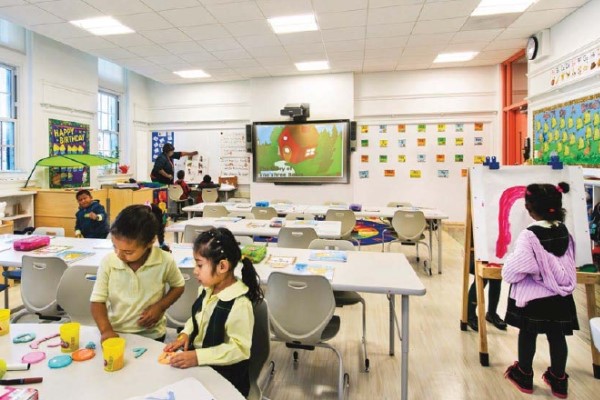A View of Facilities from Both Sides of the Table
October 01, 2017
Three guiding principles for getting the best school facility design

Every school project is a unique opportunity. Whether it’s a K-12 facility renovation in a rural town or the fourth elementary school to be built in an expanding suburban community, these buildings will provide educational spaces for future generations of students and teachers.
An educational facility’s lasting impact, however, affects more than the students and teachers who occupy it. The community will pay interest on a construction bond long after a school’s ribbon has been cut, which places an enormous fiscal responsibility on superintendents and other administrators. A school district leader essentially is serving the citizens, who “own” the schools in their jurisdiction. By extension, the administrator serves as the “owner” of the local school system’s facilities through the careful stewardship of this public trust.
During my past tenure as a central administration manager of my local school system and now in the private K-12 education sector at a global architectural firm, I have seen both sides of school design — as a client and as an architect. This dual perspective enables me to provide some practical guiding principles for public-sector owner/clients and private-sector designers who partner to create the next generation of learning environments.
GUIDING PRINCIPLE NO. 1
- Be deliberate in crafting your criteria for selecting designers.
As a public owner, a superintendent’s responsibility to the community goes well beyond its initial investment in a school’s construction. As you begin the process of selecting the right designer, you should be deliberate in crafting your selection standards. Criteria should reflect not only the specific needs of the project, but also the values and priorities of your community.
When considering selection criteria, take into account the following:
- Look for authentic thought leadership in education and school design.
Does the firm appear to have designed essentially the same school over and over again, or do they seem adept at incorporating meaningful evolutions in educational practice over time? Do they rely on buzzwords or are they committed to proven principles in school design? If you can’t tell from the proposal, ask probing questions in the interviews.
- Consider long-lasting relationships.
Does the firm have repeat clients? Even if they are new to you, it’s fair to assess their track record by considering how well they maintain their existing relationships. Ongoing partnerships can be a good indicator of a firm’s level of customer service.
- Check references carefully.
Ask other clients about their experiences and outcomes. Make phone calls. Visit nearby schools. Thoroughly vetting a firm’s reference list is a helpful way to determine whether they will be a good fit for you and your project.
Good selection criteria should weed out less-capable firms, but try to avoid unnecessarily eliminating firms that are new to you. For example, if a firm has extensive, successful experience with tough historic preservation review boards but hasn’t yet been before your review board, don’t reject the firm out of hand. It may be reasonable to assume that its skills, experience and passion about preservation are transferrable to your project. If the firm is experienced and committed to historic preservation, it can successfully manage the review process with a modicum of strategic guidance from you and your board.
If familiarity is absolutely essential, administrators could consider working with a new firm on a small- to mid-size project first. Doing so upholds the concept of free and fair competition and prevents districts from favoring only those firms with whom they are acquainted. This may go against marketing orthodoxy, but the public good demands that public owners be receptive to fair and open competition.
GUIDING PRINCIPLE NO. 2
- Expand your pool, but demand excellence.

My own experiences tell me that deliberately expanding the pool of potential firms can have a positive effect on design outcomes. Nearly 20 years ago, when I was working in the District of Columbia, the city was gearing up to launch its first major modernization program in a generation. Eventually a range of design firms emerged — from nationally recognized companies to regional suburban school designers to the city’s own top-notch private and higher education designers who understood its urban fabric, historic precedents and high-profile approval processes.
The outcome of this competitive mix has been a new generation of schools that are innovatively designed and well-considered, as well as an expanded pool of architects who understand the challenges of urban school design — all of which have helped transform the city’s educational landscape.
In Maryland, where I spent several years as a central-office administrator in Prince George’s County, the state has a rigorous program of standards and approvals for public school construction. Some of Maryland’s 24 school systems insist on hiring only architects with previous experience with the state’s approvals process. Those guidelines and rules, while extensive and detailed, are in my opinion readily “learnable.” If I thought a firm was exceptional in design, I would try to educate them on the Maryland approvals process because it was far better for me, working in the public sector, to expand the pool of firms than to adhere to restrictive criteria that would unnecessarily eliminate quality options.
As these experiences convey, school design should not be restricted only to those firms that provide low-bid, off-the-shelf buildings. If you consider a school’s 40-year plus life span, each new school or major renovation project is an investment in a building that will serve generations of students. Even in instances where a prototype design is used, a quality design firm will update plans and adapt the site to meet the unique needs of whichever community or district they are serving.
Some architects are more deliberate than others in taking care to create a sense of place scaled for children and supportive of education. Efforts to discern the difference will benefit thousands of children for years to come.
GUIDING PRINCIPLE NO. 3
- Understand the importance of reputation.
This last principle may seem obvious, but I have seen it overlooked. Both public-sector owners and private-sector architects have reputations — whether well-established or newly formed.
In the private sector, I frequently hear conversations about what a certain public client is like to work with and whether firms seek out or avoid these clients because of this reputation. If your goal is to use the best designers — those who are ideally suited for your program and who will charge you reasonable fees — you must protect your personal and district’s reputation. Most markets are small enough that word gets around.
Participatory Process
Being a good client does not mean being a pushover. It’s perfectly OK to be demanding. A good client is one who makes expectations clear at the outset. For example, in Arlington, Va., where I worked for years, the district has a regionally famous and highly intensive design-vetting process used by its burgeoning school system called “The Arlington Way.
Arlingtonians are known for their fierce adherence to participatory decision making wherever public schools are concerned, so, when I directed the school construction pro-gram there, I knew my architects would be required to participate in a dozen or more community meetings to finalize a design for a single school.
It was to my benefit, as a public-sector owner and as a steward of this intensive process, to ensure the architects we hired understood from the outset that community participation would be intense, meaningful and well-managed, something we spelled out clearly in the scopes of work and the contracts. We selected our design firms partly on their ability to make the most of this highly public design process. Winning firms priced their services accordingly, and Arlington got The Arlington Way at a fair value, successfully carried out and with no contract amendments.
The partnerships we form as we create educational spaces should be informed by thorough examination of our criteria, an openness to new possibilities, and a never-ending commitment to our communities. Administrators and designers alike share the responsibility in ensuring our schools are designed on budget, on time and always with the needs of the students and teachers in mind.
Author
Advertisement
Advertisement
Advertisement
Advertisement



